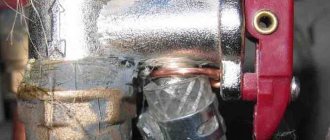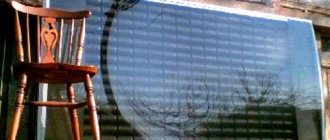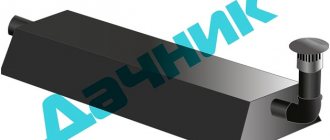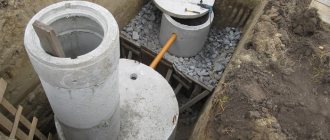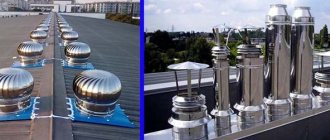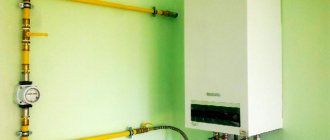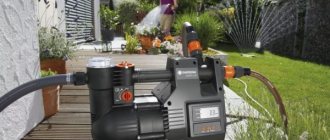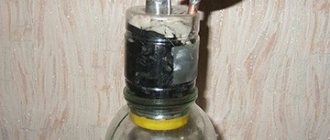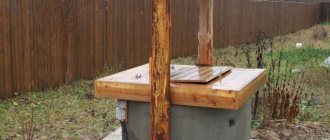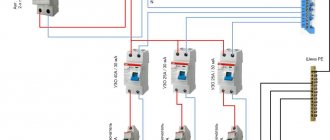The alarm went off
The turning on of the alarm lamp on the lid of the septic tank indicates that the receiving chamber is overfilled, which usually occurs due to malfunctions in the operation of Topas, or a malfunction of the alarm itself.
Solution Stop using the sewer. Open the lid of the septic tank, inspect it and continue reading this material. There is a lot of useful information here.
| Important! Regularly check the operation of the alarm system - it will help you notice a breakdown in time and prevent costly repairs. |
How to avoid malfunctions
Proper operation of the device and timely maintenance will help you avoid serious breakdowns of the Topas septic tank. Of course, force majeure cannot be ruled out, but you can protect your station from the most common malfunctions. What does that require:
- Be careful what chemicals you use. There is a wide range of biodegradable and safe laundry, dishwashing and floor cleaning products on the market. The light did not converge on “Fairy”.
- Do not allow non-degradable waste (candy wrappers, condoms, pads, hair) to get into the septic tank.
- Maintain the station regularly.
- Make sure that the station is always connected to the network. If the power is turned off, do not use the sewer.
- Do not exceed the permissible salvo release.
- Install an alarm. It will notify you in a timely manner about a malfunction of the Topas septic tank and help you avoid serious problems.
- Check the operation of the station from time to time by opening the cover.
- Trust the installation, maintenance and repair of your septic tank only to professionals. For example, !
sells, installs and services Topas septic tanks in Moscow and Moscow Region, St. Petersburg and Leningrad Region, as well as in Pskov, Yekaterinburg and Veliky Novgorod.
The hazard warning light periodically comes on and then goes off.
If you use the Topas system in normal mode, not a lot of waste flows, and the lamp on the lid sometimes lights up and goes out after a while, this indicates a decrease in the performance of the main mamut pump in the receiving chamber. Due to blockage or insufficient air supply, the amount of pumped waste is reduced, causing a short-term overflow of the receiving chamber and the lamp operating.
Solution Clean the overflow assembly and check the air supply.
Popular methods of cleaning septic tanks
Today, cleaning and pumping septic tanks is carried out in various ways.
- Mechanical – the use of specialized equipment (sewage truck) and the services of professional specialists. In cases where it is necessary to decompose the layers, appropriate effective preparations are first applied. Moreover, the cost of the work does not depend on the volume of the tank, but on the fixed price for the service itself.
- Chemical – the use of effective chemicals intended for cleaning and disinfecting sewer system wastewater. The most popular products include formaldehyde, nitrogen fertilizers, bleach and ammonium compounds.
They ensure rapid decomposition of large fractions, disinfect large amounts of wastewater, eliminate unpleasant odors, soften deposits at the bottom of containers, and reduce the volume of sediment.
- Biological – the use of bio bacteria is characterized by maximum effect. Microorganisms that become active after entering the liquid medium inside the container are absolutely safe for any structure.
After their use, the silty sediment decreases in volume, and the septic tank requires less frequent pumping and removal of sediment.
Dirty water leaving the septic tank
During normal operation of Topas, purified water from the septic tank should not have any color and in appearance it is no different from water from the tap. If the water at the outlet is brown, this may be due to a high concentration of activated sludge in the aeration tank. If maintenance is not done on time, then there is too much silt and it leaves along with the purified water, giving it a brown or black color. In this case, it is necessary to carry out service and the problem will be resolved. It also makes sense to check the performance of the recirculation airlift located in the aeration tank.
The color of purified water can be affected by improper use of the treatment plant, for example, the discharge of large amounts of household chemicals due to a lack of fecal waste, the ingress of petroleum products, and chlorine-containing preparations. But here, in addition to the color of the water, 99% of the unpleasant smell will be added. In this case, a restart of the septic tank is required (maintenance with pumping out all contents with a sewage disposal machine).
Solution Service is required.
The difference between a septic tank and a cesspool and VOCs
The main differences between a cesspool and a septic tank are the features of their designs:
- a pit is one tank, a septic tank is a whole system of containers;
- the container at the pit is not airtight, it clogs the surrounding soil, emits an unpleasant odor, the septic tank, due to its absolute tightness, does not differ in these properties;
- the pit requires frequent cleaning, and septic tanks can be pumped out every few years.
In addition, pits are easy to create with your own hands, and installation of septic tanks requires a professional approach. By their design, factory septic tanks are distinguished by a well-thought-out system, each element of which serves to implement a certain stage of purification of waste water entering the tank.
The greater the daily amount of wastewater that comes out of the autonomous drainage system, the more impressive the volume of the septic tank should be. Otherwise, this can lead to rapid overflow of tanks and ineffective wastewater treatment.
Clean water does not come out into the drain
Solution Check the clean water drain line for blockages or freezing. The water exit must be unobstructed. If your Topas is equipped with a drainage pump (modification PR), check its operation from an external outlet. Check to see if the pump float is touching the walls of the chamber in which it is installed.
Recommendations for choosing a septic tank for a summer house and country house
When choosing a treatment plant, it is important not only to know how the septic tank works properly, but also to take into account the operating conditions. For example, when installing a sewer system for a country house, it is not advisable to choose expensive VOCs with aerobic bacteria. Such septic tanks function only with a constant supply of electricity and a continuous flow of wastewater.
When a treatment system is required for a country house where a family lives, it should be understood that the wastewater will contain household chemicals and construction dust. Therefore, when choosing a septic tank, give preference to those models that have filters that separate foreign matter that bacteria cannot process.
Note!
How soil purification occurs: if you need to drain 1 cubic meter of filtered wastewater, you need 10 m2 of filtration field. Therefore, when you have a small plot, you should choose septic tanks without soil treatment. For example, equip a treatment facility made of concrete rings.
Before choosing the location of the septic tank, calculate whether a sewer truck can drive up to it. If the treatment plant is a factory-made one, insoluble sludge will have to be pumped out annually. The sewer truck has a hose up to 10 m long. If a longer length is required, be prepared for additional costs. Vacuum trucks should not drive through your garden and spoil the beds, so the septic tank should be placed next to the roadway, and so that the treatment facility does not interfere with the residents of neighboring houses.
Odor coming from the sewer when flushing the toilet
This is due to the fact that when the toilet is flushed, a large burst of water is flushed into the sewer. When water is flushed down the drain, it pushes some of the air out, filling the bathroom with an unpleasant odor.
Solution Check whether the vent riser or check valve is working in the house. It happens that owners, out of ignorance, neglect these plumbing solutions when installing a sewer system. In this situation, you should consider installing at least a check valve on the sewer riser.
PS
And a little more moralizing. Some owners of private houses and cottages install a toilet that regulates water discharge. Simply put, it saves water. This is necessary to ensure that the septic tank chamber is not overloaded from excess wastewater.
The fact is that if water is used excessively, heavy particles in the sump will no longer settle to the bottom, but will move into the decomposition chamber. In it, filtration will not be as effective and these same particles will gradually clog the holes in the filtration field and the soil will not be able to absorb a large amount of water. And as a result, the sewer system will be overflowing.
Take the example of thrifty owners, do not flush chemicals and construction waste down the drain, and then the septic tank will serve you for a long time!
- < Back
- Forward >
Knocks out the automatic fuse in the panel to which the Topas is connected
Deep wastewater treatment systems always contain electrical components (pumps, floats, compressors, etc.), so a malfunction can occur in any of them.
Solution As they say: electrical engineering is the science of contacts. The machine knocks out - this means that the load current has exceeded, caused by a short circuit. You need to look for a fault in the electrical part of the Topas, checking each component in turn. Pay special attention to the control unit of the treatment plant. In 90% of cases the problem is there. For some reason, manufacturers do not pay enough attention to the tightness of the block, which is why the contacts of the terminal block oxidize, and if it is overfilled, it immediately floods. Knowing this problem, our company has developed a universal control unit with IP54 protection level, which is suitable for almost all Topas models and analogues.
Electrical diagrams can be found.
Universal control unit
Unpleasant odor near biological stations
In the case of biological treatment plants, an unpleasant odor clearly indicates a malfunction. Unlike flow-through septic tanks, aerobic bacteria are responsible for the main purification processes in them, which do not emit unpleasant-smelling gases when processing contaminants. This is possible when cleaning processes are disrupted.
Among the most likely reasons are:
- Death of aerobic microflora of “activated sludge” in the aeration tank chamber. May occur after using aggressive chlorine-containing detergents.
- Low load on the cleaning station. As a result, bacteria do not have enough food to reproduce.
- Long power outages cause aeration processes to stop, which also leads to oxygen starvation and death of activated sludge.
The solutions to the problem in the listed cases are clear. Do not use aggressive chemicals, do not allow long power outages and idle downtime. After a long period of inactivity, flushing special bacteria or ordinary semolina into the toilet, which gives impetus to the development of aerobic microflora, sometimes helps to “start up” the septic tank.
The RCD in the house is turned off
An RCD is a residual current device controlled by differential (residual) current. In Russian - RCD - a fire prevention mechanism that protects a person from electric shock in the circuit where it is installed.
Over the years of our company's work, we have encountered cases where, for unknown reasons, the RCD located in the electrical panel turns off in a house. Having spent a long time figuring out why this is happening, we came to the conclusion that the RCD turns off due to the occurrence of a leakage current inside the septic tank. Since there is 100 percent humidity inside the septic tank, an aggressive environment, add to this the leakage of sockets and the control unit = the likelihood of such a situation occurring is by no means zero.
Solution De-energize the septic tank! And look for the cause of the leak by checking each electrical component individually. Or call our customer service - we will help!
How to pump out a septic tank at a summer cottage
All types of septic tanks require high-quality cleaning. When the device is properly configured, there is almost no increase in the liquid level in the container. However, over time, its qualitative composition changes, because silt deposits accumulate.
To prevent it from being compressed into a dense crust, the septic tank in private housing construction or on a summer cottage is periodically cleaned.
The cleaning procedure can be performed in two ways:
- calling a sewage disposal truck with a team of professionals;
- use the Jemix Festock 250 fecal pump and a transport container to solve the problem yourself.
Both options, which allow you to pump out the septic tank in a short time, do not involve any particular difficulties. However, the work of professionals is characterized by greater efficiency, efficiency and quality.
At the same time, the cost of pumping is quite economical, which makes it possible to quickly solve the problem of a septic tank that has filled with sewage in a private home.
The Topas receiving chamber is overfilled or all compartments are filled with water
Almost any malfunction in the Topas septic tank causes a gradual overflow of the receiving compartment. Following the reception, all the compartments begin to fill up and water can rise to the electrical compartment.
The cause may be a malfunction of the air compressor, a clog in the main mamut pump (when the septic tank has been in operation for a long time without maintenance), or a failure of the float in the receiving chamber, which is responsible for switching operating cycles. all the main reasons for the overflow of the Topas septic tank in our article, but do not rush to click on the link - below are described malfunctions that can also lead to overflow, but are not covered in the mentioned article.
Solution Be sure to stop using the sewer. There can be many reasons for overflow; you need to accurately determine the cause of the overflow in order to avoid its recurrence. To do this, read the article further.
Septic tank freezing
The structure itself is a source of heat, which is released during the decomposition of waste. However, in the north and in severe winters, freezing is possible.
To avoid this, the cover of the autonomous sewer system should be insulated (for example, with extruded polystyrene foam), and several layers of insulation should be laid on top of the structure itself. Pipes, both inlet and for the discharge of treated wastewater, should be laid, if possible, below the soil freezing level, or additionally insulated.
Note! When laying pipes, it is necessary to maintain a slope of 2 cm per meter of sewer line! Otherwise, wastewater will accumulate in the pipes and may freeze, clogging the drain!
"Topas" is turned on, but nothing is bubbling inside
Solution Check the availability of electricity in the house, make sure that the circuit breaker in the panel responsible for the septic tank is on. If your septic tank is connected to an outlet, check the connection and functionality of the outlet.
Check for voltage at the input to the control unit; the cable running from the house to the treatment station may be damaged. Inspect the terminal block in the control unit for oxidation or loose contacts. Check the operation of the power button using a multimeter. “Ring” compressor sockets. When working, follow safety precautions.
SEPTIC CENTER
10 ANSWERS to 10 QUESTIONS
about SEPTICS and AUTONOMOUS SEWERAGE
COUNTRY HOUSE
1. What is “aerobic” and “anaerobic” sewerage?
Depending on the design, sewers are divided into two types according to cleaning methods - aerobic and anaerobic. In fact, the process of operation of an autonomous sewage system is based on the method of biological treatment, the principle of which boils down to the fact that special bacteria break down organic substances.
Depending on the type of sewerage, biological treatment methods can be divided into aerobic (the life of bacteria requires oxygen, which is pumped into the septic tank with a special pump and this requires electricity) and anaerobic (bacteria live in the absence of oxygen).
2. How far away from the house can a septic tank be installed?
The sanitary zone from the septic tank should be 5 meters. In the sanitary zone, any buildings and structures are prohibited, including sheds, fences, etc. (according to SNiP 2.04.03-85 clause 1.10).
3. What is soil purification?
This is a method of post-treatment of wastewater that has been pre-treated in a septic tank. The wastewater flows into the drainage tunnel, from where it is distributed over the surface of the gravel filter, after which, already purified, it goes into the ground. Soil purification occurs due to soil self-filtration. Bacteria in the soil break down organic particles, making them harmless to the environment.
4. Is it possible to use the septic tank and station in winter?
Yes, you can. But it is important to remember that the most optimal conditions for the life of all bacteria, including in sewers, are a warm environment. To do this, in order to prevent their death in winter, the septic tank and station must be insulated. Special insulation is placed on the upper surface of the septic tank and the station; you can use ordinary expanded clay or polystyrene foam. The same material should be used to insulate the pipes through which the drains pass. This measure will create additional protection for the system and ensure uninterrupted operation of the sewerage system.
5. How long does it take to install a septic tank and station?
Each time the installation takes a different time, since everything is very individual. The installation consists of two stages: excavation and installation. Under standard conditions, the total time takes on average 2 days.
6. What cannot be discharged into the septic tank and station?
— The following cannot be discharged into a septic tank or station:
— polymer films and other biologically non-degradable compounds,
including fuels and lubricants, paints, solvents;
- construction garbage;
— chlorine-containing substances, acids and alkalis;
— garden fertilizers;
- medicines;
Discharge of the above waste into a septic tank and station can lead to the destruction of microorganisms that process sewage waste.
7. ADDITIONAL EQUIPMENT
WHAT IS USED FOR WHAT?
Often, in addition to the basic set of equipment for autonomous sewerage, consisting of a septic tank or local treatment plant, installation teams recommend using additional equipment. There are cases when installation of an autonomous sewer system is completely impossible without additional equipment.
Let's try to figure out what additional equipment is, how necessary it is in a given situation, and what it is used for.
An integral part of an autonomous sewage system consisting of a septic tank is a drainage tunnel. The main function of the drainage tunnel is soil post-treatment of wastewater. A septic tank, no matter how high the degree of purification it has, is not capable of providing 100% quality, therefore, in order not to pollute the environment, the wastewater undergoes additional treatment in the tunnel.
The drainage tunnel allows wastewater to be discharged into the ground, occupying a relatively small area. In addition, the drainage tunnel, due to its internal volume, is capable of absorbing excess water during a large volley discharge.
Often, to optimize the installation of an autonomous sewer system, installation teams advise installing not only a septic tank or station, but also a well. The well is a sealed barrel that performs various functions. For example, a sewer well is installed where it is not possible to install a septic tank on the same level as the house.
Rotary well - in places where pipes make sharp turns to avoid blockages. Storage - performs the function of safe storage of wastewater. But rarely does a well perform only one of these functions; more often, one such well is assigned several functions at once, taking into account the characteristics of the area.
Another additional equipment that is often offered by installers and manufacturers of containers for autonomous sewage systems is additional necks. The main purpose of the additional neck is to increase the height of the container (septic tank or station).
Installers recommend installing an additional neck when the septic tank needs to be installed very deeply (below the depth of the standard height of the septic tank), for example, when the outlet pipe from the house is installed in a large recess.
Remember, installation of an autonomous sewage system
- a matter for professionals
Contact us for competent advice:
8-980-654-0036
8. SEPTIC TANK or STATION – WHAT TO CHOOSE?
Perhaps all beginners are faced with this question - those who are planning to install an autonomous sewer system on their suburban area. Let's try to figure it out - which is better to choose?
So, on average, a person spends 200 liters of household waste per day. In urban areas, these wastewaters are quietly drained into the sewer system. And in the absence of a central sewerage system, you have to rack your brains - what to do with wastewater, which of the various sewerage systems to choose.
Undoubtedly, both septic tanks and local treatment plants have their own advantages, knowing which will make it easier to make a choice. One of the decisive factors in choosing a sewerage system is the presence or absence of constant access to electricity. The local treatment plant operates on the principle of biological treatment. For complete high-quality wastewater treatment, a periodic supply of oxygen is required using an installed compressor. Temporary power outages, of course, will not put the station out of action, but in the absence of oxygen, aerobic bacteria will begin to die, which, in turn, will reduce the quality of water purification.
Unlike stations, septic tanks do not require oxygen for high-quality wastewater treatment. In a septic tank, completely different bacteria work - anaerobic, comfortably existing, multiplying and purifying water without the participation of oxygen.
The second factor that will help you make the right choice in favor of one or another sewage system is the seasonality of living in a country house. As mentioned above, aerobic bacteria living in the station will die without constant access to oxygen. Therefore, you need to remember that when using the station seasonally, all bacteria will die and it will take time to reactivate the station after a significant break in operation. While the principle of operation of the septic tank is constructed in such a way that even after a long period of rest, to resume operation you will not have to make any special efforts - just start draining the wastewater into the septic tank again.
Another important factor that should also be taken into account when choosing an autonomous sewage system is the intensity of use and the presence or absence of additional drainage sources in the house.
So, if you plan to discharge water into the sewer not only from the toilet and sink, but also, for example, from washing machines and dishwashers, or if there are more than two baths in the house, you should choose a station.
For example, the Dochista Profi local treatment station with the largest capacity to date of 1800 liters per day is capable of withstanding the drainage of water from two toilets, two sinks, a bathtub, a shower, a washing machine and a dishwasher. This volume is quite enough for a family of 8-9 people permanently living in a country house.
Septic tanks "Dochista" are characterized by lower productivity. For example, the Dochista septic tank with the largest volume has a capacity of 1,400 liters per day and is ready to clean wastewater from a family of up to 10 people.
It is also worth paying attention to the maintenance features of each sewerage system. For example, the Dochista Profi local treatment plant does not require special maintenance that would be impossible to carry out independently. While the Dochista septic tank must be cleaned with a certain periodicity using a sewer machine.
The fifth significant factor determining the choice of sewerage is the type of soil and groundwater level. The Dochista septic tank will become your ideal sewerage system in sandy soil with low and medium groundwater levels. And the Dochista Profi station is universal for any type of soil and any groundwater level.
So, any of the autonomous sewerage systems, be it a septic tank or a local treatment plant, has its own advantages; you just need to make the right choice based on the terrain of your suburban area and the intensity of sewerage use.
All appointments are advisory in nature and we advise you to contact professionals
for competent and detailed advice on choosing not only a sewerage model,
but also its volume, as well as all necessary additional equipment: 8-980-654-0036
9. WHAT TO DO IF THE GROUNDWATER LEVEL IS HIGH AT THE SITE?
SEPTIC AT HIGH GROUNDWATER LEVEL
In the conditions of the Yaroslavl, Kostroma, Ivanovo, Tver and Vologda regions, you can often encounter groundwater levels already at a depth of 20 centimeters.
Under such conditions, it would seem impossible to install a septic tank. But of course there is a solution, and not even one:
SEPTIC WITH BULK ABSORPTION FIELD:
As practice has shown, installing a classic septic tank at a high groundwater level is possible. To do this, you simply need to install a filter cassette (Drainage tunnel) not at the level of the septic tank, but on the surface of the ground. Of course, with this solution, a mound is formed on the site, but it can be played, for example, like an alpine hill.
Now let’s learn more about the technology of installing a septic tank at high groundwater levels. The septic tank is installed in the standard way, but with mandatory anchoring to the concrete slab, since groundwater in our case is very close. It is advisable to install a distribution well after the septic tank. This will increase the degree of purification of wastewater entering the filter cassette. A submersible pump with a float switch is installed in the third chamber of the septic tank or in the distribution well. This pump pumps wastewater after the septic tank into a filter cassette installed above the septic tank and groundwater.
Filter cassette installation:
In a place determined for installation, a fertile layer of soil is removed (usually 30-50 cm) with an area larger than the cassette itself by 50 cm on all sides. Next, the resulting pit is filled with sand with a tamper to the ground level, concrete blocks 25-30 cm high are installed around the perimeter of the pit and fastened together. Granite crushed stone of fraction 20-40 is poured into the resulting container. The cassette itself is installed on the crushed stone (a drainage tunnel without a bottom). A pipe with a hose is inserted into it, through which purified liquid from the septic tank flows. And a ventilation pipe comes out of it. Now everything needs to be insulated with polystyrene foam, a layer of 10 cm. And the final stage - this entire structure is covered with soil - a layer of at least 20 cm. After this, the resulting hill can be decorated.
In this way, you can organize local sewerage using a septic tank if the groundwater level is high.
BIOLOGICAL TREATMENT STATION:
This is a simpler and more logical way. A biological treatment station “Dochista Profi” is installed, and the treated wastewater is discharged onto the terrain or into a roadside ditch. In this option, difficulties may arise only during the installation of the station itself, but experienced installers can cope with them. Another nuance of this solution is that the biological treatment station will not function normally or even not enter operating mode at all if you visit the dacha 2-3 times a month. For such cases, a Dochista septic tank with forced water rise is ideal.
10. PRESERVATION OF THE SEPTIC FOR THE WINTER
The summer season is coming to an end. Many summer residents who have a septic tank installed on their property are wondering what measures to take to protect themselves as much as possible from damage to the autonomous sewer system. So, what do you need to remember and what mistakes should you avoid in order to properly preserve your septic tank for the winter?
The main mistake of many septic tank users is completely pumping out the water before conservation.
In the spring, when the groundwater level is noticeably higher than in the summer, an empty septic tank can easily be pushed out of the ground!
It becomes quite light, such weight is not able to resist the pressure of the soil.
Remember, before leaving your septic tank for the winter, check the water level in all chambers - it should be at least ¾ of the total volume.
In this case, no pushing out of your sewer is scary. It is recommended to turn off the power supply to the entire system, dismantle the compressor and pump, if these are included in the design of your autonomous sewer system.
Try to remove all non-recyclable garbage from the septic tank, since during the conservation period its processing and water purification will be difficult. Finally, check the tightness of the lid and, preferably, insulate it with available materials. It is not recommended to fill it with sand, as it can get inside the septic tank and disrupt its operation.
All of the above measures are necessary if you plan not to use sewerage on your site for the entire winter period. However, the design of septic tanks and the Dochista station is designed in such a way as to operate continuously even in the cold season, without causing trouble to its owners.
11. SEPTIC MAINTENANCE
The operation of the wastewater treatment plant is fully automatic and does not require daily maintenance. It is only necessary to check from time to time that it is working correctly visually with the lid open and the basket raised.
: Raise the basket with the compressor to the surface of the ground. Take out the pumping hose (located under the basket), connect the airlift pump hose to the compressor. The sludge yield is approximately 20% of the chamber volume. The presently obtained sludge is in an aerobically stabilized state and can be used as fertilizer or disposed of in a compost pit.
Once every 6 months:
— cleaning the compressor filter. If there is a lot of dust in the place where the installation is working, more often. At the top of the compressor, unscrew the fastening bolt and remove the cover along with the filter. Depending on the degree of contamination, wash with water, dry, and return to place. Cleaning the airlift pumps and biological filter is carried out as follows: Release the airlift pump from the mounting support, remove the airlift pump. Rinse with water pressure.
Once every 3 years:
— replacement of compressor membranes. Instructions are included in the compressor membrane repair kit.
Once every 10 years:
— replacement of the perforated stocking of the aeration elements.
READ REVIEWS ABOUT SEPTICS AND WORK PERFORMED>>>
The compressor does not work in Topas
As we have already described in the material “Design and principle of operation of Topas”, there are 2 types of treatment plants: “Topas” and “Topas”-S. A distinctive feature of which is the number of installed blowers. In “Topas” younger models, 2 of them are installed, in “Topas”-S - one + solenoid valve.
| Important! In two-compressor septic tanks, only ONE of the two compressors should operate at a time. In single-compressor units, the only installed blower operates constantly. This is a design feature of the treatment plant. |
The easiest and most reliable way to check the operation of the blower is to disconnect it from the power supply inside the septic tank and supply it with power through an extension cord from a known working outlet from the house, shed, or garage.
Solution If the compressor does not work, it needs to be repaired. Of the possible malfunctions, three main ones can be distinguished: the membranes are torn and the protective mechanism is activated or the electromagnet fails. In the first case, repairs can be carried out on your own and you won’t have to spend a lot on spare parts. Replacing the solenoid is a more expensive repair and it is often advisable to replace the entire compressor.
Advice. In the event of a breakdown of the compressor responsible for the operation of the direct cycle, we recommend that you temporarily replace it with a compressor from the reverse cycle . This solution will help avoid overflow and force the septic tank to operate in wastewater treatment mode (direct cycle). You should not put off repairs or purchase of a new device for a long time - the proper operation of the septic tank depends on the performance of the blower.
The service engineers of the Clean World company always have with them the most popular compressors for Topas and other septic tanks.
Go to the compressor catalog
Helper Methods
Chemical and biological methods are considered auxiliary. Their main purpose is the decomposition of hard and viscous deposits and trouble-free removal. In case of siltation after their use, a sewage disposal machine will be required to pump out the liquefied substrate.
Chemicals
The following types of chemical compounds are used to clean open storage tanks and septic tanks:
- Formalin . Liquid formaldehyde was previously used as an affordable and effective disinfectant. It destroys all living bacteria, but is a strong poison for people, so it is used less and less.
- Bleaching powder . The second drug, the use of which is recommended to be avoided. Lime is a proven disinfectant, but it is very toxic, so work with it in a respirator and gloves. It is stored in a dark place - in the light the substance loses active chlorine, and its effectiveness decreases.
When you can’t do without chemistry Source mantair.com
- Ammonium salt purifiers . The preparations contain nitrogen in a tetravalent active form. They intensively dissolve organic matter and eliminate unpleasant odors. At the same time, they are very toxic. Therefore, one of the main conditions for the task of how to clean a septic tank with ammonium salts is the remote location of the country toilet from residential buildings (ideally, at least 15-20 m from the house). To clean the waste pit, only vacuum pumping is suitable.
- Nitrate oxidizers (nitrogen fertilizers) . Compared to other chemicals, this is the most gentle option. Nitrate compounds decompose any organic matter, eliminate odor, and the result of their work can be used as fertilizer. The disadvantage of oxidizing agents is their high cost. When communications and the electric pump of a septic tank come into contact with metal, they form salt on the surface, which can lead to overgrowing of pipes and damage to the device.
Ammonium preparations are used away from housing Source ogorod.ru
The compressor in the septic tank works, but does not blow
This behavior of a blower can be observed when the rubber membranes (diaphragms) in the compressor rupture. The compressor appears to be working, but there is no aeration in the compartments.
Solution You need to disconnect the compressor from the air duct tube and check whether air is coming out of its opening. When you pinch the hole with your finger, you should feel the pressure of the air trying to escape. If there is no pressure, the membranes need to be replaced. You must purchase the required kit for your compressor. The kit always contains two diaphragms and, depending on the manufacturer, fasteners for them. We carry out replacement according to the instructions. We rejoice in the straightness of our hands and the savings. By the way, membranes are consumables, and according to the manufacturer’s instructions, they must be changed every 2 years. Although in practice membranes can last much longer.
Video on how to replace membranes yourself
The recommended period for cleaning the air filter is every six months. Replace it every year. From experience we can say that it is really worth cleaning the filter more often, especially since it is a quick and free procedure. Replacement can be done less frequently; once every 2 years is sufficient.
Rules for using a septic tank - for those who want to keep it in perfect condition!
Details Published 02/19/2021
It would seem that you set it once and forget it. But, unfortunately, this is not entirely true. A septic tank requires special care and there are special rules for its use. If you don’t follow them, the repairs will cost you a pretty penny: from approximately 50 thousand rubles. Well, its complete replacement will be equal to the cost of your broken septic tank + dismantling the old one.
How should you handle a septic tank so as not to send it to a landfill after the first three months of use? Let's look at it in this article!
Two compressors in Topas operate simultaneously
Now let's consider a situation where two compressors operate simultaneously.
This is possible when the float switch responsible for changing operating cycles is broken. The Topas has a two-position float, inside of which there is a ball that closes either one group of contacts (upper position) or another - lower position.
Due to wear on the mechanism, sometimes the ball closes two groups of contacts at the same time.
Solution Replace the float. As a temporary solution, you can knock on the float so that the ball is released and starts working as expected. True, such a measure will not be enough for a long time; soon it will “stick” again.
It also happens that the float is depressurized or the cable is frayed. In this case, the wastewater enters the float and closes both contact groups, as a result of which power is supplied to both compressors.
Pros and cons of septic tanks without pumping
The construction of treatment facilities requires careful design and precise execution, otherwise all sorts of troubles are guaranteed. But a properly designed drive during operation provides the user with a number of advantages:
- There are no unpleasant odors from sewerage on the site.
- There is no need to often call sewage disposal equipment, since almost the entire volume of wastewater passing through the sewer system is technologically neutralized.
- The risk of soil contamination is significantly reduced, since the degree of disinfection is very high. However, you must comply with the requirements for removing septic tank elements without pumping from sources of drinking water - wells and wells.
- The duration of use of treatment facilities can be tens of years.
However, for septic tanks without pumping there are specific disadvantages that may affect their performance:
- Before choosing the design of a sewerage facility, it is necessary to study the nature of the soils on the site. There are situations when installing your own treatment system is completely impossible, for example, if at the installation site there are dense clay soil substrates that prevent filtration.
- The treatment system must be properly designed taking into account the slopes of the connecting pipes.
- It is necessary to ensure 100% tightness of the entire system, taking into account seasonal soil movements. In this case, it is preferable to use solid-body systems made of plastic.
Sewage without pumping after a year.
The negative aspects in the use of such elements are very significant and require increased attention, but they do not at all indicate the impossibility of their use.
If all calculations are carried out correctly and the project is executed exactly, problems with the use of VOCs will not arise for 25-30 years.
The main mamut pump (air lift) in Topas is not working.
In the dedicated article we have already indicated the most common case. Now it's time to cover this issue in more detail.
The main pump, which pumps wastewater from the receiving compartment to the aeration tank, may not work for several reasons:
1. The malfunction is due to clogging of the main pump and/or the coarse filter in the receiving compartment. All wastewater enters this chamber and there, with the help of aeration, it undergoes mechanical crushing. If you pour insoluble waste down the drain, it will either settle to the bottom of the chamber over time or may cause a blockage. Vegetable skins, wet wipes, polyethylene bags - all this cannot be poured down the drain.
Solution The overflow assembly and inlet chamber need to be cleaned. You can do this yourself, or call ours. We will professionally service your septic tank.
Operating principle of the main pump.
2. There is no purge of the main mamut pump. The animation diagram above clearly demonstrates that it requires an air supply to operate. If air does not flow or there is not enough air supplied, then liquid pumping will not take place.
Solution Remove the air tubes from the pump. Check if there is air supply from the compressor when the direct cycle is on and the compressor is running. Check the air distributor nozzles and air duct hoses.
Check the air ducts and nozzles of the Topas distributor
3. The cycle switch float sensor does not work
Solution Replace the float switch in the receiving chamber. The mamut pump should only operate when the cycle switch float is raised up. You will need an on-on float switch with a cable length of 3m.
Device installation procedure
It is not difficult to supplement the design of a septic tank with a compressor, but you will still have to work hard. If the septic tank is two-chamber, then it is better to add a third compartment to it, designed for aeration of wastewater and called an aeration tank. It is here that the wastewater will be saturated with air and purified using aerobic microorganisms.
To do this, you will have to go through all the stages of creating a septic tank: dig a pit, install a sealed container made of plastic, concrete or other suitable material in it, connect it to the sewer pipe leading from the house, connect it with an overflow to other compartments of the septic tank, install a lid, etc.
In industrial production VOCs, a separate protected space is provided for installing a septic tank so that the device does not come into contact with the contents of the sewer
It is better to mount the compressor in the upper part of the container, rather than outside, so that the device is reliably protected from bad weather. To do this, a special shelf is made inside, right next to the lid, on which the compressor is subsequently placed.
It would be even safer to make a more insulated compartment to protect the device from accidental wetness and other damage.
To use a compressor in a homemade septic tank, it is necessary to make an additional compartment - an aeration tank, into which O2 will be supplied. In this case, concrete rings or other suitable materials can be used, but the walls from the inside should be waterproofed with lime or clay
It is necessary to provide a hole in the cover for the compressor electrical wire. You will also need another hole through which air will flow into the compressor.
You need to install a plastic pipe inside the aeration tank. Its lower end should be hermetically sealed, and the walls should be perforated. Usually it is enough to make about three hundred holes or a little less.
It is better to do this with a drill with a two-millimeter drill bit. Through these holes, compressed air will enter the thickness of the wastewater, saturating it with oxygen and crushing large solid waste. The holes should be approximately equal distance apart so that the air is distributed evenly. The upper part of the pipe is connected to the compressor using a hose.
The aerator for the compressor is made of an ordinary plastic pipe with a hermetically sealed end and uniform perforation on the surface
When all the elements are prepared, the following steps should be followed:
- Lower the aerator into the aeration tank.
- Install the compressor in the designated place.
- Connect the aerator with a hose to the compressor outlet.
- Connect the device to power supply.
- Turn on the compressor.
- Close the septic tank lid.
Now all that remains is to regularly inspect the device and periodically, approximately twice a year, clean the air filter. This operation is not difficult to perform. The location of the filter is indicated on the device diagram in the manufacturer's instructions.
You need to unscrew the protective cover; it is usually held in place by mounting bolts. Then carefully remove the filter, rinse it and dry it. After this, the cartridge is placed in its original place and closed with a lid.
When storing a septic tank for the winter, the compressor should be disconnected from the aerator and power supply and stored in a heated room.
If, upon inspection of the septic tank, it is discovered that the operating compressor is noisier than usual or the presence of some extraneous noise is detected, this is a cause for concern. If you leave everything as is, the compressor will soon break down.
Sometimes standard air filter cleaning helps. But if the noise does not decrease, you should invite a specialist to diagnose the problem or apply for warranty service.
If the septic tank is located in a country house or in a country house where the sewage system is not used all year round, it is necessary to preserve the septic tank, with the obligatory shutdown and removal of the compressor.
Correct installation is the basis for stable operation
Some septic tank users notice that they carefully use the system, do not drain aggressive compounds, and pump out wastewater on time. Despite all their efforts, their system still fails. The reason for this turns out to be incorrect installation.
Installation affects not only the environmental situation on the site, but also the operation. Therefore, you should not organize a sewer system yourself without having the necessary skills and knowledge for this.
Only professionals who have been working with septic tanks for a long time know the nuances:
- ♻️ Choosing a place. Not every area on the site allows it to be used for a septic tank. It is necessary to measure the distance to the nearest source of drinking water, to the foundation of the house and other objects.
- ♻️ Check the soil type and its condition.
- ♻️ Selecting the type of septic tank and materials.
During the installation process, the craftsmen see the “weak points” on your site and build the system so that it does not cause inconvenience during operation. They will advise site owners on how to properly use this type of sewer system.
Not all owners of septic installations take seriously how to work with an autonomous sewer system. This is an important issue, as it concerns not only the convenience of waste disposal, but also the health of all users. Compliance with the standards established by manufacturers and craftsmen guarantees a long period of use in a safe manner.

